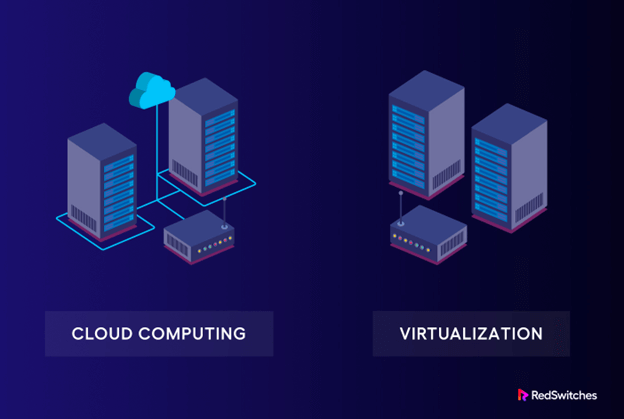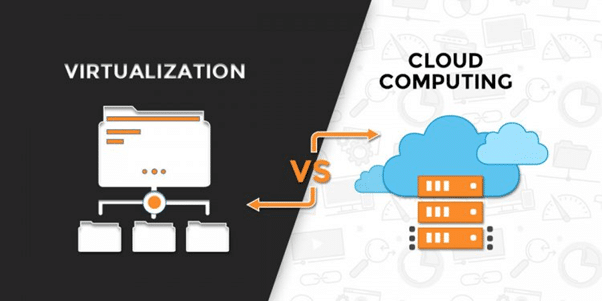Many people use cloud computing and virtualization to refer to virtually delivering computing resources as the operations need. However, despite their shared features, the two have considerable variations, such as the capacity to share resources, increased efficiency, and costs.
Cloud computing and virtualization are valuable options for building and maintaining your company’s IT infrastructure. This article will compare cloud computing with virtualization, discuss their unique benefits and help you decide the best choice for your company’s specific requirements. Let’s get started!
Tbale Of Content
- What is Cloud Computing?
- What is Virtualization?
- How Virtualization and Cloud Computing Relate
- Differences Between Virtualization and Cloud Computing
- Advantages of Virtualization Over Cloud Computing
- Factors to Consider When Choosing a Virtualization Provider
- How to Determine Whether Your Business Needs a Cloud Solution or Virtualized Environment
- Should You Move From On-Premises Virtualization to Cloud Computing?
- Conclusion
What is Cloud Computing?
The term “cloud computing” describes providing resources such as servers, networks, applications, networking, and more to users remotely.
This involves accessing and using on-demand computing resources by business processes without requiring the ownership and management of infrastructure.
The flexibility, scalability, and cost reductions that cloud computing provides revolutionize how businesses run. It is now a crucial component of the overall business processes and service delivery to internal users and customers.
How Cloud Computing Works
Cloud computing operates by using remote servers and associated resources (located in installations called data centers) in various locations worldwide. Google, AWS, and Microsoft Azure are the leading cloud service providers owing to optimum infrastructure maintenance and security.
Customers use a subscription model where they pay on a pay-as-you-go basis to access computing resources from the providers. This allows businesses to finetune resource allocation and usage and minimize wastage.
Use Cases for Cloud Computing
There are many uses for cloud computing. For example:
- Machine Learning and AI: Cloud computing offers the capacity to execute complicated AI and ML algorithms. ChatGPT, the most famous example of ML, is hosted on Microsoft Azure cloud.
- Web and Mobile Applications: Cloud service providers offer the best platforms for hosting online and mobile applications. This enables companies to expand their customer base and scale their service delivery.
What is Virtualization?
In broad terms, virtualization refers to a system that enables multiple software stacks (a combination of OS, application files and assets, and dependencies) to share the resources of a single physical machine. These resources include storage, CPU, memory, and networking.
A virtualized environment runs on a shared pool of physical resources, but it looks like a dedicated physical platform to a specific software stack and users. Because of this architecture, virtualization has emerged as a crucial technology for building flexible and powerful computing infrastructures that can run multiple projects on a physical server.
How Virtualization Works
Virtualization establishes an abstraction layer between the physical hardware and the software stacks running on it. The hypervisor or virtual machine monitor is the intermediate layer responsible for setting up virtual machines, resource allocation, and ensuring that each software stack has an isolated environment to execute the code.
Each virtual machine can have its copy of the operating system, apps, and data and get a share of the physical computing, storage, and networking resources.
Use Cases for Virtualization
Virtualization use is widespread across many markets, such as:
- Software Development and Testing: Virtualization enables programmers to build and test applications in a customizable virtual setting without setting up specialized hardware environments.
- Cloud Computing: Virtualization is a major technology used in many types of cloud computing to operate several virtual computers on a single physical machine. It allows for the effective use of resources while enhancing the flexibility and scalability of the entire cloud infrastructure.
How Virtualization and Cloud Computing Relate
Virtualization and cloud computing are similar on the surface, but they differ in many ways. For instance, you can run multiple operating systems on a single machine using virtualization to significantly increase efficiency.
Cloud computing allows users to access applications and data from anywhere worldwide and eliminates the need for on-premises infrastructure. Cloud computing often relies on virtualization technology to power the underlying infrastructure.
To summarize the differences, virtualization is the foundational technology enabling cloud computing. Similarly, cloud computing encompasses a broader range of services and applications beyond virtualization alone.
Differences Between Virtualization and Cloud Computing
Image Source: Amaze
Now that you know the similarities between virtualization and cloud computing, it is also essential to understand how these two differ to make an informed decision. Here’s a table outlining the key differences between cloud computing and virtualization:
| Cloud Computing | Virtualization | |
| Purpose | Enables on-demand access to shared computing resources | Allows multiple operating systems and applications or helps to run on a single physical computer |
| Management | Managed by an internal service provider | Managed by an internal or external IT administrator |
| Cost | Typically pay-as-you-go pricing model | Requires upfront investment in hardware and software |
| Security | Security is the responsibility of the service provider | Security is the responsibility of the IT administrator |
| Scalability | Can be easily scaled up or down based on changing requirements | Limited scalability as the underlying physical hardware constraints resource availability |
| Examples | ● Amazon Web Services
● Google Cloud Platform |
● Hyper-V
● Oracle VirtualBox |
Advantages of Virtualization Over Cloud Computing
Virtualization and cloud computing are two powerful technologies that provide numerous advantages to businesses. Although virtualization is a fundamental facilitator of cloud computing, virtualization offers some benefits over cloud computing.
● Increased Control and Flexibility
Virtualization provides better control and adaptability for an organization’s computing infrastructure. It grants a more significant degree of freedom and control in establishing one’s virtual machine’s settings.
Cloud computing typically provides fewer opportunities for customization because it depends on external vendors to handle the underlying infrastructure.
● Enhanced Security
Virtualization permits the development of sandboxed virtual environments; you can evaluate and test suspected malicious software without endangering the production environment. Cloud computing often depends on security measures implemented by the cloud provider.
● Better Resource Utilization
Through virtualization, tighter utilization of hardware resources can effectively reduce costs and boost efficiency. However, cloud computing suffers from the inherent limitations of sharing resources.
● Lower Cost
Virtualization can save money for businesses by portioning a physical machine into multiple VMs. Organizations can save money on new hardware and cloud service fees by developing virtual environments on their current infrastructure. Contrarily, there are continually recurring costs for cloud services when using cloud computing.
There are many significant benefits of using virtualization and cloud computing. However, before committing to a particular technological solution, businesses should thoroughly assess their unique circumstances.
Factors to Consider When Choosing a Virtualization Provider
Choosing a virtualization provider can be crucial when a business wants to optimize its computing infrastructure. Some things to think about are:
- Compatibility: The virtualization service should work with the company’s current set of hardware and applications. This requires a comprehensive audit of the current OS, software, hardware usage, and future requirements.
- Scalability: The virtualization setup must be flexible enough to meet the organization’s current and projected demands. You should consider scalability and support for many virtual machines essential.
- Performance: The virtualization provider must deliver high performance and low latency, especially for mission-critical applications and workloads.
- Security: The virtualization service provider should use robust security protocols to prevent hacking, data loss, and other security incidents.
- Support: The virtualization service you choose should have a round-the-clock expert support team to assist if you run into trouble
How to Determine Whether Your Business Needs a Cloud Solution or Virtualized Environment
Businesses that need high scalability in a cloud computing environment would benefit the most from cloud solutions.
Why?
Because:
- They provide scalability and ease of resource provisioning. Thanks to pay-as-you-go pricing, businesses only need to pay for the resources they use.
Organizations that don’t have in-house server management expertise can also benefit from cloud solutions. This is because many vendors offer managed services for the infrastructure’s day-to-day upkeep and security.
Virtualized solutions are ideal for businesses that need more control, customization, and performance from their IT infrastructure. Here’s why:
- Virtual machines can be set up on existing hardware, with better control over resource allocation.
- Efficiency in using available resources, with customizable environments that can be removed when they’re not needed anymore.
Virtualized solutions require more hands-on management and maintenance of the underlying infrastructure. Therefore, they are best suited for businesses with in-house server management talent.
Should You Move From On-Premises Virtualization to Cloud Computing?
Your IT setup, strategic goals, and funds are just a few variables that will determine your company’s best course of action between virtualization and cloud computing. Consider the following:
● Scalability
Cloud computing’s capacity to dynamically increase or decrease allocated resources is a significant selling point. Through RedSwitches, moving your virtualization infrastructure to the cloud is a great option. We can help you if your on-premises setup is straining under the current demand or if you anticipate a surge in usage soon.
● Cost
If you have a significant or unexpected workload, cloud computing may be more cost-effective than virtualization deployed on-premises.
Instead of buying and maintaining equipment that may sit unused for long periods, businesses can use private clouds and pay only for the needed resources.
On-site virtualization might be more economical in some circumstances, notably for smaller businesses or those with steady workloads.
● Security
Security may be the ultimate factor in your decision to go to the cloud. Therefore, you should consider the cloud providers’ security features to ensure they can accommodate your stringent security standards.
In addition, for safety reasons, some businesses may find on-premises virtualization more appealing due to the greater degree of control and flexibility it provides.
● Compliance
Your business may need to keep data and workloads in-house because of regulatory and compliance requirements. As with any significant change, assessing compliance needs and confirming that transitioning to the cloud will avoid violations is essential.
The decision to relocate your business should come after carefully considering its individual needs and requirements.
Conclusion
The decision between cloud computing and virtualization depends on many factors. The good thing is that cloud computing and virtualization can benefit enterprises considerably. What makes one better than the other is how well it fits the needs and objectives of a business.
Here is the best part: We at RedSwitches provide the best-in-class cloud solution for businesses. With our services, you will deliver uninterrupted services without worrying about scalability, performance, and security.


